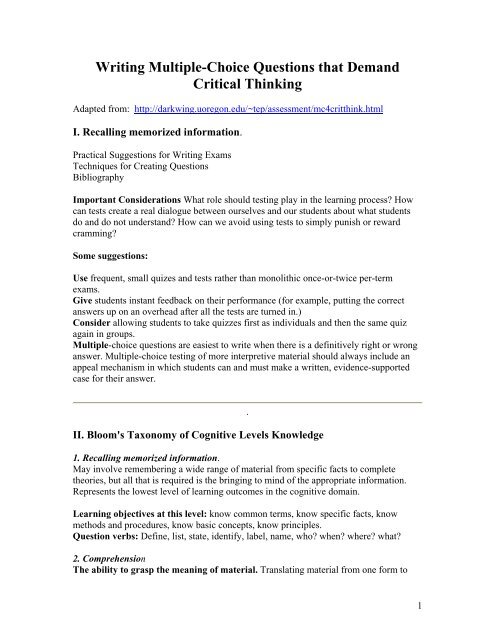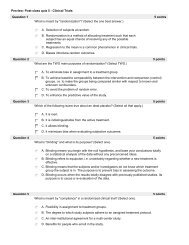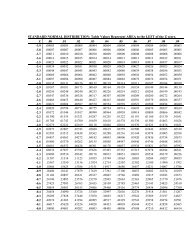Writing Multiple-Choice Questions that Demand Critical Thinking
Writing Multiple-Choice Questions that Demand Critical Thinking
Writing Multiple-Choice Questions that Demand Critical Thinking
Create successful ePaper yourself
Turn your PDF publications into a flip-book with our unique Google optimized e-Paper software.
<strong>Writing</strong> <strong>Multiple</strong>-<strong>Choice</strong> <strong>Questions</strong> <strong>that</strong> <strong>Demand</strong><br />
<strong>Critical</strong> <strong>Thinking</strong><br />
Adapted from: http://darkwing.uoregon.edu/~tep/assessment/mc4critthink.html<br />
I. Recalling memorized information.<br />
Practical Suggestions for <strong>Writing</strong> Exams<br />
Techniques for Creating <strong>Questions</strong><br />
Bibliography<br />
Important Considerations What role should testing play in the learning process? How<br />
can tests create a real dialogue between ourselves and our students about what students<br />
do and do not understand? How can we avoid using tests to simply punish or reward<br />
cramming?<br />
Some suggestions:<br />
Use frequent, small quizes and tests rather than monolithic once-or-twice per-term<br />
exams.<br />
Give students instant feedback on their performance (for example, putting the correct<br />
answers up on an overhead after all the tests are turned in.)<br />
Consider allowing students to take quizzes first as individuals and then the same quiz<br />
again in groups.<br />
<strong>Multiple</strong>-choice questions are easiest to write when there is a definitively right or wrong<br />
answer. <strong>Multiple</strong>-choice testing of more interpretive material should always include an<br />
appeal mechanism in which students can and must make a written, evidence-supported<br />
case for their answer.<br />
II. Bloom's Taxonomy of Cognitive Levels Knowledge<br />
1. Recalling memorized information.<br />
May involve remembering a wide range of material from specific facts to complete<br />
theories, but all <strong>that</strong> is required is the bringing to mind of the appropriate information.<br />
Represents the lowest level of learning outcomes in the cognitive domain.<br />
Learning objectives at this level: know common terms, know specific facts, know<br />
methods and procedures, know basic concepts, know principles.<br />
Question verbs: Define, list, state, identify, label, name, who? when? where? what?<br />
2. Comprehension<br />
The ability to grasp the meaning of material. Translating material from one form to<br />
.<br />
1
another (words to numbers), interpreting material (explaining or summarizing),<br />
estimating future trends (predicting consequences or effects). Goes one step beyond the<br />
simple remembering of material, and represent the lowest level of understanding.<br />
Learning objectives at this level: understand facts and principles, interpret verbal<br />
material, interpret charts and graphs, translate verbal material to mathematical formulae,<br />
estimate the future consequences implied in data, justify methods and procedures.<br />
Question verbs: Explain, predict, interpret, infer, summarize, convert, translate, give<br />
example, account for, paraphrase x?<br />
3. Application<br />
The ability to use learned material in new and concrete situations. Applying rules,<br />
methods, concepts, principles, laws, and theories.<br />
Learning outcomes in this area require a higher level of understanding than those under<br />
comprehension.<br />
Learning objectives at this level: apply concepts and principles to new situations, apply<br />
laws and theories to practical situations, solve mathematical problems, construct graphs<br />
and charts, demonstrate the correct usage of a method or procedure.<br />
Question verbs: How could x be used to y? How would you show, make use of, modify,<br />
demonstrate, solve, or apply x to conditions y?<br />
4. Analysis<br />
The ability to break down material into its component parts. Identifying parts, analysis of<br />
relationships between parts, recognition of the organizational principles involved.<br />
Learning outcomes here represent a higher intellectual level than comprehension and<br />
application because they require an understanding of both the content and the structural<br />
form of the material.<br />
Learning objectives at this level: recognize unstated assumptions, recognizes logical<br />
fallacies in reasoning, distinguish between facts and inferences, evaluate the relevancy of<br />
data, analyze the organizational structure of a work (art, music, writing).<br />
Question verbs: Differentiate, compare / contrast, distinguish x from y, how does x<br />
affect or relate to y? why? how? What piece of x is missing / needed?<br />
5. Synthesis<br />
(by definition, synthesis cannot be assessed with multiple-choice questions.<br />
It appears here to complete Bloom's taxonomy.) The ability to put parts together to form<br />
a new whole.<br />
relate to y? why? how? What piece of x is missing / needed?<br />
This may involve the production of a unique communication (theme or speech), a plan<br />
2
of operations (research proposal), or a set of abstract relations (scheme for classifying<br />
information).<br />
Learning outcomes in this area stress creative behaviors, with major emphasis on the<br />
formulation of new patterns or structure.<br />
Learning objectives at this level: write a well organized paper, give a well organized<br />
speech, write a creative short story (or poem or music), propose a plan for an experiment,<br />
integrate learning from different areas into a plan for solving a problem, formulate a new<br />
scheme for classifying objects (or events, or ideas).<br />
Question verbs: Design, construct, develop, formulate, imagine, create, change, write a<br />
short story and label the following elements:<br />
6. Evaluation<br />
The ability to judge the value of material (statement, novel, poem, research report) for<br />
a given purpose. The judgments are to be based on definite criteria, which may be<br />
internal (organization) or external (relevance to the purpose). The student may determine<br />
the criteria or be given them. Learning outcomes in this area are highest in the cognitive<br />
hierarchy because they contain elements of all the other categories, plus conscious value<br />
judgments based on clearly defined criteria.<br />
Learning objectives at this level: judge the logical consistency of written material,<br />
judge the adequacy with which conclusions are supported by data, judge the value of a<br />
work (art, music, writing) by the use of internal criteria, judge the value of a work (art,<br />
music, writing) by use of external standards of excellence.<br />
Question verbs: Justify, appraise, evaluate, judge x according to given criteria. Which<br />
option would be better/preferable to party y?<br />
III. Practical Suggestions for <strong>Writing</strong> <strong>Multiple</strong>-<strong>Choice</strong> <strong>Questions</strong><br />
General Suggestions<br />
1) Do not write the test in one day. Spread the work out over time. <strong>Questions</strong> demanding<br />
high-level thinking take longer to craft-professional item writers often write only 3 or 4<br />
per day. Write one or two questions after each class, so it becomes a simple matter of<br />
assembling them into an exam. Some teachers keep a rubber-banded stack of note cards<br />
in their desk for this purpose.<br />
2) If students are to hand-write the letters of their chosen answers, ask them to use<br />
CAPITAL LETTERS. The handwritten, lower-case letters "a" and "d" and "c" and "e"<br />
can be difficult to distinguish when scoring.<br />
3
<strong>Writing</strong> the Stem<br />
1) Phrase stems as clearly as possible-confusing questions can generate wrong<br />
answers from students who do understand the material.<br />
For example, a confusing stem like: "According to Tuckman's model, groups develop<br />
through several stages over time. Furthermore, it contradicts Poole's activity-track model<br />
which has groups switching among several different linear sequences. Which of the<br />
following is not one of the stages identified in Tuckman's model?" could be cleaned up to<br />
read: "Tuckman's model of group development includes: [Select all <strong>that</strong> apply]"<br />
2) Avoid extra language in the stem.<br />
Some think extraneous details make a question more complex. However, they most often<br />
just add to the students' reading time. This reduces the number of questions you can put<br />
on a test, therefore reducing the reliability of the test. For example, in the Tuckman<br />
question above, the information on Poole's model had nothing to do with the information<br />
sought by the question.<br />
3) Include any language in the stem <strong>that</strong> you would have to repeat in each answer<br />
option. For example, a stem such as "Biology is defined as the scientific study of:" keeps<br />
you from having to repeat "is the scientific study of" at the beginning of each option.<br />
Answer Options<br />
1) Avoid lifting phrases directly from text or lecture. This becomes a simple recall<br />
activity for the student. Use new language as frequently as possible.<br />
2) Most literature recommends writing the correct answer before writing the<br />
distracters. This makes sure you pay enough attention to formulating the one clearly<br />
correct answer.<br />
3) Answer options should be about the same length and parallel in grammatical<br />
structure. Too much detail or different grammatical structure can give the answer away.<br />
For example, the specificity and grammatical structure of the first option here are dead<br />
give-aways:<br />
The term "side effect" of a drug:<br />
a) refers to any action of a drug in the body other than the one the doctor wanted to drug<br />
to have.<br />
b) is the chain effect of a drug.<br />
c) additionally benefits the drug.<br />
4) Limit the number of answer options. Research shows <strong>that</strong> three-choice items are<br />
about as effective as four-choice items. Four choice items are the most popular, and never<br />
give more than five alternatives.<br />
4
5) Distracters must be incorrect, but plausible. If you can, include among the<br />
distracters options <strong>that</strong> contain common errors. Students will then be motivated to listen<br />
to your explanations of why those options are incorrect.<br />
6) To make distracters more plausible, use words <strong>that</strong> should be familiar to students.<br />
7) If a recognizable key word appears in the correct answer, it should appear in some or<br />
all of the distracters as well. Don't let a verbal clue decrease the accuracy of your exam.<br />
For example, someone with no biology background would not have to think very hard to<br />
make a correct guess on this question:<br />
Every organism is made of cells and every cell comes from another cell. This is the:<br />
a) Relativity Theory<br />
b) Evolution Theory<br />
c) Heat Theory<br />
d) Cell Theory<br />
8) Help students see crucial words in the question.<br />
For example: "Which of the following is NOT an explicit norm?" Likewise, when you<br />
ask a similarly-worded question about two different things, always highlight the<br />
difference between the questions.<br />
9) It is often difficult to come up with 3 or 4 plausible distracters, and teachers will<br />
sometimes add some <strong>that</strong> are not plausible, or even humorous. Be careful.<br />
If it is too easy to eliminate one or two options, then the question loses much of its<br />
measurement value. If energy or time is limited and you must come up with one more<br />
distracter, consider either offering a true statement <strong>that</strong> does not answer the question<br />
and/or a jargon-ridden option <strong>that</strong> is meaningless to someone who understands the<br />
concept.<br />
10) Use Rarely:<br />
Extreme words like "all," "always" and "never" (generally a wrong answer). Vague words<br />
or phrases like "usually," "typically" and "may be" (generally a correct answer).<br />
"All of the above" - eliminating one distracter immediately eliminates this, too.<br />
"None of the above" - use only when the correct answer can be absolutely correct, such<br />
as in math, grammar, historical dates, geography, etc.. Do not use with negatively-stated<br />
stems, as the resulting double-negative is confusing. Studies do show <strong>that</strong> using "None of<br />
the above" does make a question more difficult, and is a better choice when the<br />
alternative is a weak distracter.<br />
5
IV. Some Techniques for <strong>Writing</strong> <strong>Multiple</strong>-<strong>Choice</strong> Items <strong>that</strong> <strong>Demand</strong><br />
<strong>Critical</strong> <strong>Thinking</strong><br />
1) Premise - Consequence<br />
Students must identify the correct outcome of a given circumstance.<br />
Example: If nominal gross national product (GNP) increases at a rate of 10% per year<br />
and the GNP deflator increases at 8% per year, then real GNP:<br />
a) Remains constant.<br />
b) Rises by 10%.<br />
c) Falls by 8%.<br />
d) Rises by 2%.<br />
Note: To increase the difficulty, provide more than one premise.<br />
2) Analogy<br />
Students must map the relationship between two items into a different context:<br />
Example: E-mail is to an unmoderated listserv as office hours are to:<br />
a) Class lecture.<br />
b) Class discussion.<br />
c) Review sessions.<br />
d) Tutorials.<br />
3) Case study A single, well-written paragraph can provide material for several followup<br />
questions.<br />
Example:<br />
2) Alice, Barbara, and Charles own a small business: the Chock-Full-o-Goodness Cookie<br />
Company. Because Charles has many outside commitments and Barbara has a few, Alice<br />
tends to be most in touch with the daily operations of Chock-Full-o-Goodness. As a<br />
result, when financial decisions come down to a vote at their monthly meeting, they have<br />
decided <strong>that</strong> Alice gets 8 votes, Barbara gets 7, and Charles gets 2-with 9 being required<br />
to make the decision.<br />
According to minimum-resource coalition theory, who is most likely to be courted for<br />
their vote?<br />
a) Alice<br />
b) Barbara<br />
c) Charles<br />
d) No trend toward any specific person.<br />
6
3) In the scenario in question 2, according to minimum-power coalition theory, who is<br />
most likely to be courted for their vote?<br />
a) Alice<br />
b) Barbara<br />
c) Charles<br />
d) No trend toward any specific person.<br />
4) Incomplete Scenario<br />
Students must respond to what is missing or needs to be changed within a provided<br />
scenario.<br />
Note: when using a graph or image, try to lay it out differently than how the students<br />
have seen it. This is equivalent to using new language to present a familiar concept and<br />
prevents students from using rote memorization to answer the question.<br />
For example, the diagram below may originally have been split left to right instead of top<br />
to bottom, and this diagram may not be as detailed as the diagram they saw in the book.)<br />
Example: Use the diagram below to answer the following questions.<br />
1) What belongs in the empty box in the upper right corner of the diagram?<br />
a) Hardware devices<br />
b) Client Services for Netware<br />
c) Logon Process<br />
d) Gateway Services for Netware<br />
2) If the Applications resided below the heavy black line, they would:<br />
a) be open to hackers on the network.<br />
b) compete with the OS for memory.<br />
c) be preemptively multi-tasked.<br />
d) launch in individual NTVDMs.<br />
5) Problem/Solution Evaluation Student are presented a problem and a proposed<br />
solution. They must then evaluate the proposed solution based upon criteria provided.<br />
Example: A student was asked the following question: "Briefly list and explain the<br />
various stages of the creative process."<br />
As an answer, this student wrote the following:<br />
"The creative process is believed to take place in five stages, in the following order:<br />
orientation, when the problem must be identified and defined, preparation, when all the<br />
possible information about the problem is collected, incubation, when no solution seems<br />
in sight and the person is often busy with other tasks, illumination, when the person<br />
experiences a general idea of how to arrive at a solution to the problem, and finally<br />
verification, when the person determines whether the solution is the right one for the<br />
problem."<br />
7
How would you judge this student' s answer?<br />
a) EXCELLENT (all stages correct in the right order with clear and correct explanations)<br />
b) GOOD (all stages correct in the right order, but the explanations are not as clear as<br />
they should be)<br />
c) MEDIOCRE (one or two stages are missing OR the stages are in the wrong order, OR<br />
the explanations are not clear OR the explanations are irrelevant)<br />
d) UNACCEPTABLE (more than two stages are missing AND the order is incorrect<br />
AND the explanations are not clear AND/OR they are irrelevant)<br />
V. Bibliography of <strong>Multiple</strong>-<strong>Choice</strong> Question Resources<br />
Books:<br />
Bloom, Benjamin B. (Ed.) Taxonomy of Educational Objectives: the classification of<br />
educational goals, by a committee of college and university examiners 1st Ed. New York:<br />
Longmans, Green, 1956.<br />
Davis, Barbara Gross. Tools for Teaching San Francisco: Jossey-Bass, 1993.<br />
Erickson, Bette LaSere and Diane Weltner Strommer. Teaching College Freshmen San<br />
Francisco: Jossey-Bass, 1991.<br />
Jacobs, Lucy Cheser and Clinton I. Chase. Developing and Using Tests Effectively: A<br />
Guide for Faculty San Francisco: Jossey-Bass, 1992.<br />
McKeachie, Wilbert. Teaching Tips: Strategies, Research, and Theory for College and<br />
University Teachers (9th Ed.) Lexington, Mass: D.C. Heath and Company, 1994.<br />
Miller, Harry G., Reed G. Williams, and Thomas M Haldyna. Beyond Facts: Objective<br />
Ways to Measure <strong>Thinking</strong> Englewood Cliffs: Educational Technology Publications,<br />
1978.<br />
Articles:<br />
Clegg, Victoria L. and William E. Cashin. "Improving <strong>Multiple</strong>-<strong>Choice</strong> Tests." Idea<br />
Paper #16, Center for Faculty Evaluation and Development, Kansas State University,<br />
1986.<br />
Fuhrman, Miriam. "Developing Good <strong>Multiple</strong>-<strong>Choice</strong> Tests and Test <strong>Questions</strong>."<br />
Journal of Geoscience Education 44 (1996): 379-384.<br />
Johnson, Janice K. ". . . Or None of the Above." The Science Teacher 56.2 (1989) 57-61.<br />
Web-sites:<br />
University of Capetown's Guide to Designing and Managing <strong>Multiple</strong> <strong>Choice</strong> <strong>Questions</strong><br />
An excellent site from which much of our workshop material was adapted.<br />
8
















